
- •Лекция 1. Fundamental concepts of electromagnetics. Electrostatics. (Начало электростатики)
- •Vectors and scalar fields. (Векторные и скалярные поля)
- •Electrostatic field. (Электростатическое поле)
- •Coulomb’s Law. (Закон Кулона)
- •Electric Field Strength e and Displacement Field d. (Напряжённость и смещение электрического поля)
- •Gauss’ Law. (Закон Гаусса)
- •Electric Potential. (Электрический потенциал)
- •Work in the electric field. (Работа в электрическом поле)
- •Dielectric polarization. (Диэлектрическая поляризация)
- •Dielectric material characteristics. (Характеристики диэлектриков)
- •Properties of dielectric materials. (Свойства диэлектрических материалов)
- •Poisson’s and Laplace’ s equations. (Уравнения Пуассона и Лапласа)
- •Лекция 2. Boundary conditions for the Laplace or Poisson equations (Граничные уравнения для уравнений Лапласа и Пуассона)
- •Electrostatic Energy (Электростатическая энергия)
- •Virtual experiment. (Эксперимент по нахождению энергии системы)
- •Consequences (Следствия)
- •Continuity Equation (Уравнение непрерывности)
- •Лекция 3. Static magnetic field (Статическое магнитное поле)
- •Variables and units (Переменные и единицы измерения)
- •Main Relations (Основные соотношения)
- •Magnetic flux density (Индукция магнитного поля)
- •Biot-Savart’s law (Закон Био-Савара)
- •Ampere’s law (Закон полного тока)
- •Scalar magnetic potential (Скалярный магнитный потенциал)
- •The cut in the space (Разрез в пространстве)
- •Laplace equation for the scalar magnetic potential (Уравнение Лапласа для скалярного магнитного потенциала)
- •Vector magnetic potential (Векторный магнитный потенциал)
- •Magnetic flux (Магнитный поток)
- •Differential equation for the vector magnetic potential (Дифференциальное уравнение для векторного магнитного потенциала)
- •Gauging of the vector magnetic potential (Калибровка векторного магнитного потенциала)
- •Integral presentation of the vector magnetic potential (Интегральное представление векторного потенциала)
- •Inductance (Индуктивность)
- •Mutual inductance (Взаимная индуктивность)
- •Inductance of thin contours (Индуктивность тонких контуров)
- •Field intensity inside a cylindrical conductor (Напряжённость поля внутри цилиндрического проводника)
- •Лекция 4. Method of images (метод зеркальных изображений)
- •Equivalent charge density (эквивалентная плотность заряда)
- •Method of images for cylindrical boundaries between dielectrics (метод изображений цилиндрических границ между диэлектриками) Problem formulation (постановка задачи)
- •The inverse point (обратная точка)
- •Normal component of the field intensity (нормальная составляющая напряжённости поля)
- •Geometrical relations (геометрические соотношения)
- •Angles (углы)
- •Field induced by the line sources (поле, индуцированное линейными источниками)
- •The field sources for the external domain (источники полей для внешней области)
- •The field sources for the internal domain (источники полей для внутренней области)
- •Image method for the flat boundary between magnetic media (Метод изображений для плоской границы между магнитными носителями)
- •Equivalent magnetic charge density (Эквивалентная плотность магнитного заряда)
- •Dependence of the field intensity on the coordinate (Зависимость напряжённости поля от координаты)
- •Inductance of the two-wire transmission line per unit length (Индуктивность двухпроводной линии передачи на единицу длины)
- •Total inductance (Общая индуктивность)
- •Forces. The first line. (Силы. 1ая линия)
- •Forces. The second line. (Силы. 2ая линия)
- •Лекция 5. Solution of Laplace’s equation by separation of variables. (Решение уравнения Лапласа методом разделения переменных) Application of Laplace’s equation (Применение уравнения Лапласа).
- •Choice of a coordinate system (Выбор системы координат)
- •Variable separation in cylindrical coordinates (Разделение переменных в цилиндрических координатах)
- •Angular function (Угловая функция)
- •Radial function (Радиальная функция)
- •General solution of the Laplace’s equation in a cylindrical coordinate system (Общее решение уравнения Лапласа в цилиндрической системе координат)
- •Application of the variable separation method for the magnetic field modeling (Применение метода разделения переменных для моделирования магнитного поля)
- •Reduced scalar magnetic potential (Редуцированный скалярный магнитный потенциал)
- •Combination of scalar magnetic potential and reduced magnetic potential (Комбинация скалярного магнитного потенциала и редуцированного магнитного потенциала)
- •The scalar potential induced by the current line (Скалярный потенциал, индуцируемый линией тока)
- •The current potential in the cylindrical coordinate system (Потенциал от линии с током в цилиндрической системе координат)
- •The current potential in the complex plane (Потенциал от линии с током в комплексной плоскости)
- •Expansion of the current potential in the cylindrical coordinate system (Разложение потенциала от линии с током в цилиндрической системе координат)
- •Potentials in the problem domain (Потенциалы в проблемной области)
- •Inductance of the two-wire transmission line per unit length (Индуктивность двухпроводной линии передачи на единицу длины)
- •The flux induced by the magnetized cylinder (Поток, индуцируемый намагниченным цилиндром)
- •Лекция 6. Time dependent electromagnetic fields (Зависящие от времени электрические поля)
- •Faraday’s Law (Закон электромагнитной индукции)
- •Lenz’s Law (правило Ленца)
- •Induction by a temporal change of b (Индукция за счёт временного изменения b)
- •Induction through the motion of the conductor (Индукция за счёт движения проводника)
- •Induction by simultaneous temporal change of b and motion of the conductor (Индукция одновременным изменением во времени b и движением проводника)
- •Unipolar generator (Униполярный генератор)
- •Hering’s paradox (Парадокс Геринга)
- •Periodic electromagnetic field in the conductors. (Периодическое электромагнитное поле в проводниках)
- •Penetration of the electromagnetic field into a conductor. (Проникновение электромагнитного поля в проводник)
- •The skin effect. (Скин-эффект)
- •Poynting’s Theorem. (Теорема Пойнтинга) Electromagnetic Field Energy. (Энергия электромагнитного поля)
- •The rate of decrease of the electromagnetic field energy in a closed volume. (Скорость уменьшения энергии электромагнитного поля в замкнутом объёме)
- •Energy flows in the electromagnetic field (Поток энергии в электромагнитном поле)
- •Transmission of energy in a dc line (Передача энергии в линиях постоянного тока)
- •Transmission of energy in a dc line (Передача энергии в линиях постоянного тока)
- •The field picture near the wires with current (Картина поля вблизи провода с током)
- •Energy flows in static fields (Поток энергии в статических полях)
- •The momentum of the electromagnetic field (Момент электромагнитного поля)
- •The momentum of the electromagnetic field (Момент электромагнитного поля)
- •Лекция 8. Numerical Methods of the Electromagnetic Field Modeling. (Численные методы моделирования электромагнитного поля) Classification of the numerical methods (Классификация численных методов)
- •Classification of the problems (Классификация проблем)
- •Classification of the methods (Классификация методов)
- •Method of moments (Метод моментов)
- •Discretization of the problem domain (Дискретизация проблемной области)
- •Algebraic equation system (Алгебраическая система уравнений)
- •Finite element method (Метод конечных элементов)
- •Discretization (Дискретизация)
- •Finite functions (Ограниченная функция – отлична от нуля только в пределах треугольника)
- •Approximation of functions inside triangles (Аппроксимация функций внутри треугольника)
- •Approximation of the equation (Аппроксимация уравнения)
- •Weighted residual method (метод взвешенных невязок)
- •Galerkin method (метод Бубнова-Галеркина)
- •Weak formulation (ослабленная формулировка)
- •First type boundary conditions (Первый тип граничных условий)
- •The potential and field intensity (Потенциал и напряжённость поля)
Classification of the methods (Классификация методов)
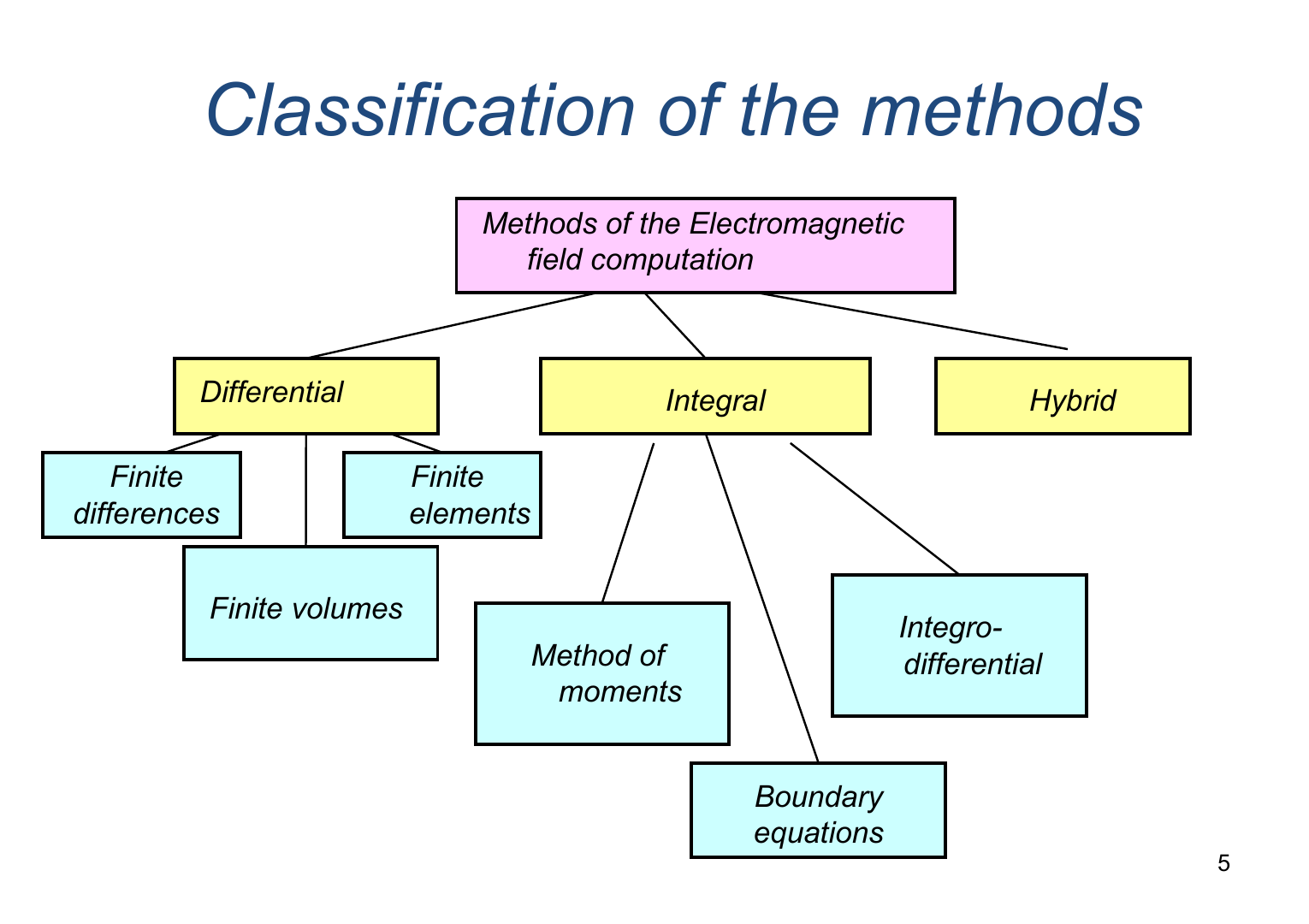
Finite difference – метод сеток (метод конечных разностей)
Finite elements – метод конечных элементов (используется в Quickfield)
Finite volumes – метод конечных объемов
Method of moments (method of spatial equations) – метод моментов
Boundary equations – метод граничных уравнений
Integro-differential – интегрально-дифференциальный метод
Hybrid method combines several methods (Boundary equations+ Finite elements)
Method of moments (Метод моментов)
This method is quite simple but is not very accurate. It is usually applied to solving magnetic problems. The basis of this method is a system of a several basic equations.
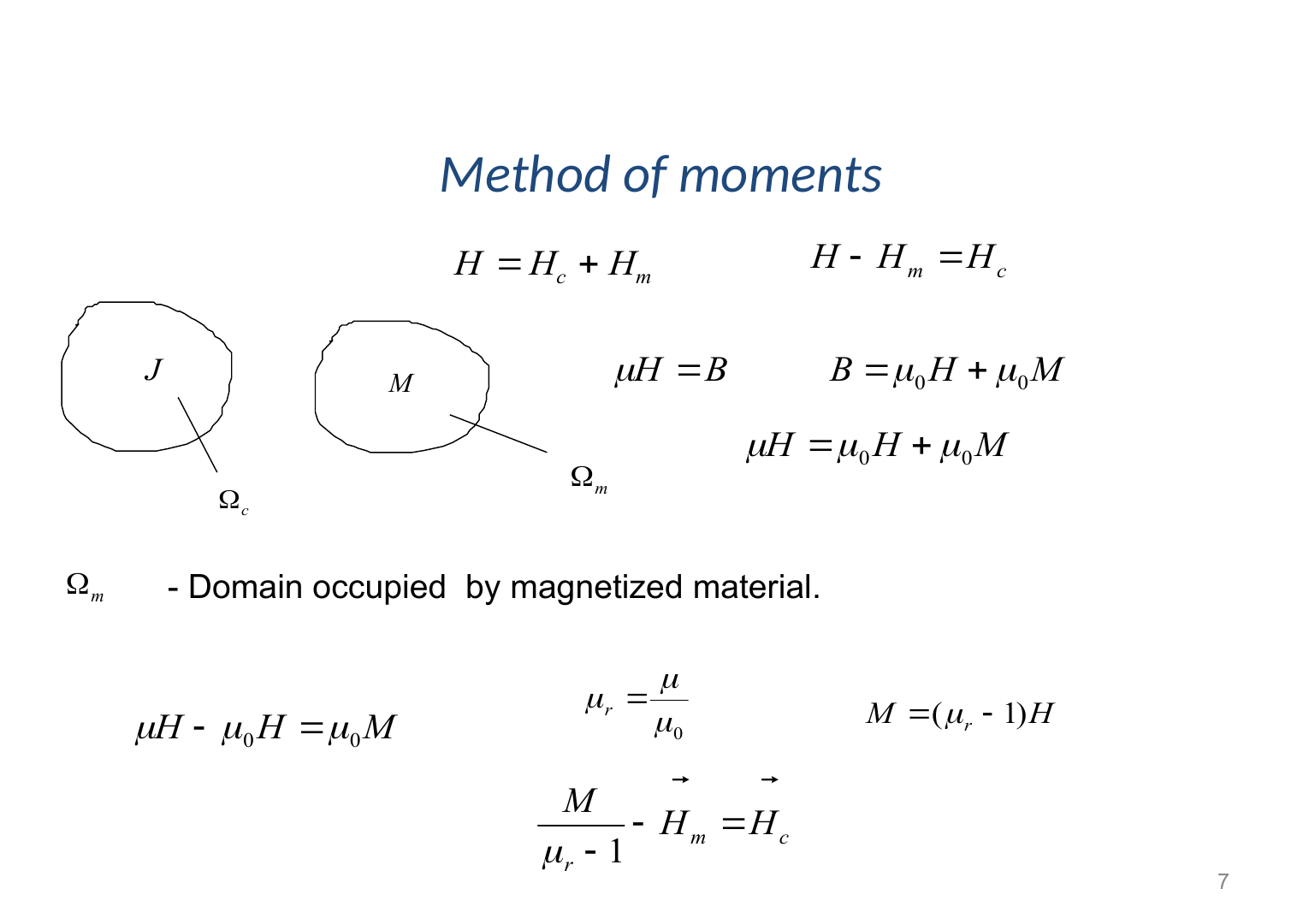
Hm – magnetic field induced by the magnetized object
Hc – magnetic field induced by the current (may be calculated independently on solving the general problem by Biot-Savart Law or another)
Here and then we shall assume, that we work inside isotropic medium.
The general system may consist of volume which if field with magnetize material (область M). may be ferromagnetic (H=102–103) or a material with smaller magnetic permeability. Another part of the volume is the field with the primary sources (область J) (usually currents, but also it may be permanent magnet)
These two volumes are surrounded by air or vacuum. In principle the domain may be infinitely big (tend to infinity). Method of moments hasn’t boundaries, so in this case it is more accurate, than other methods.
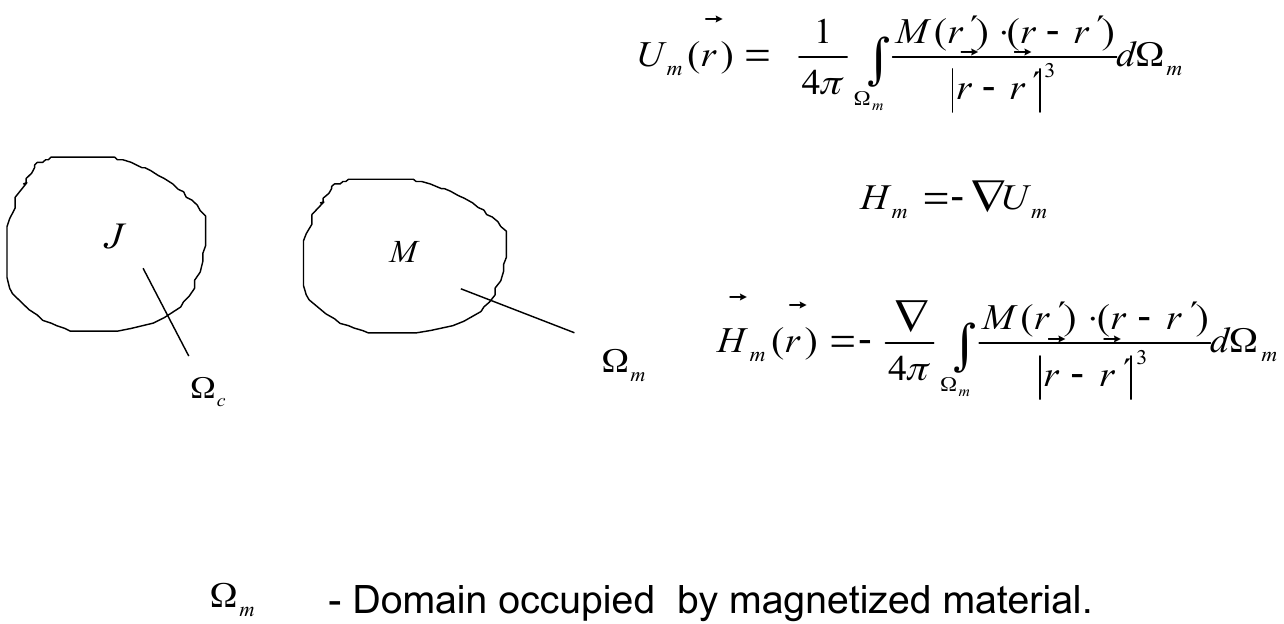
The first relation is some kind of the Coulomb Law for the magnetic field. So, we use magnetization instead of charges.
We have changed a variable. Now is not field intensity the unknown value, but magnetization.
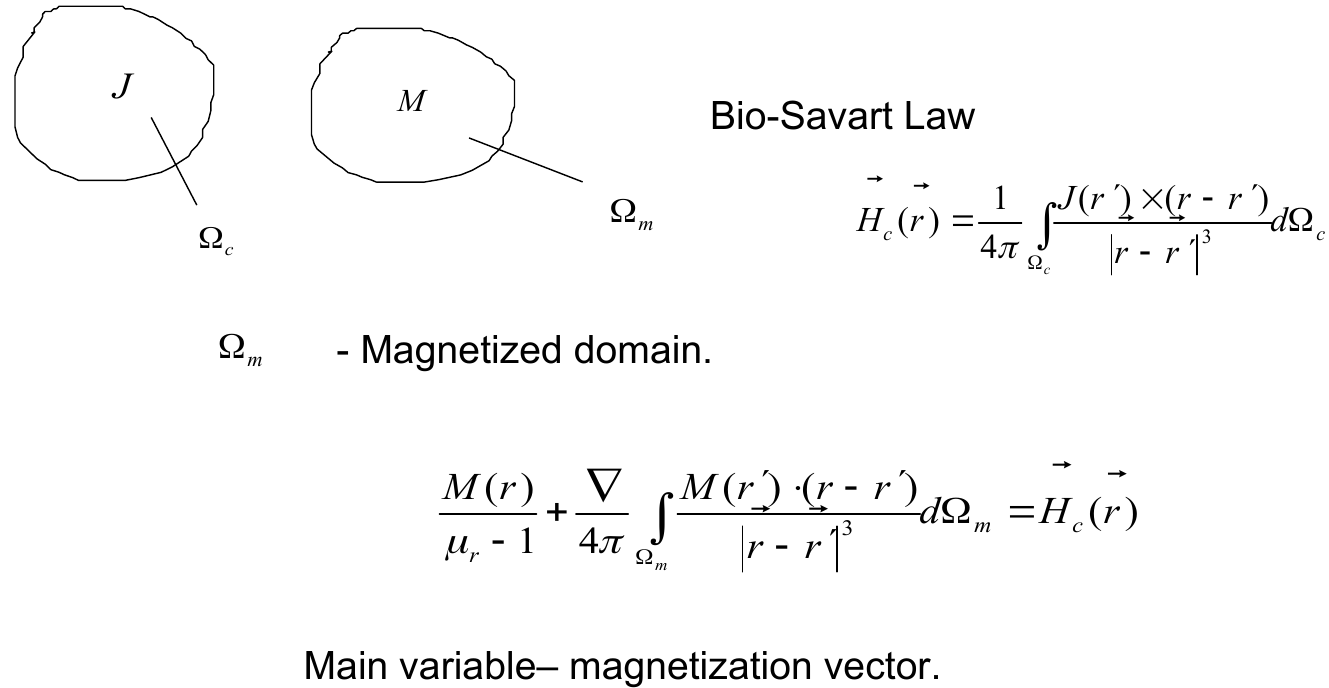
Discretization of the problem domain (Дискретизация проблемной области)
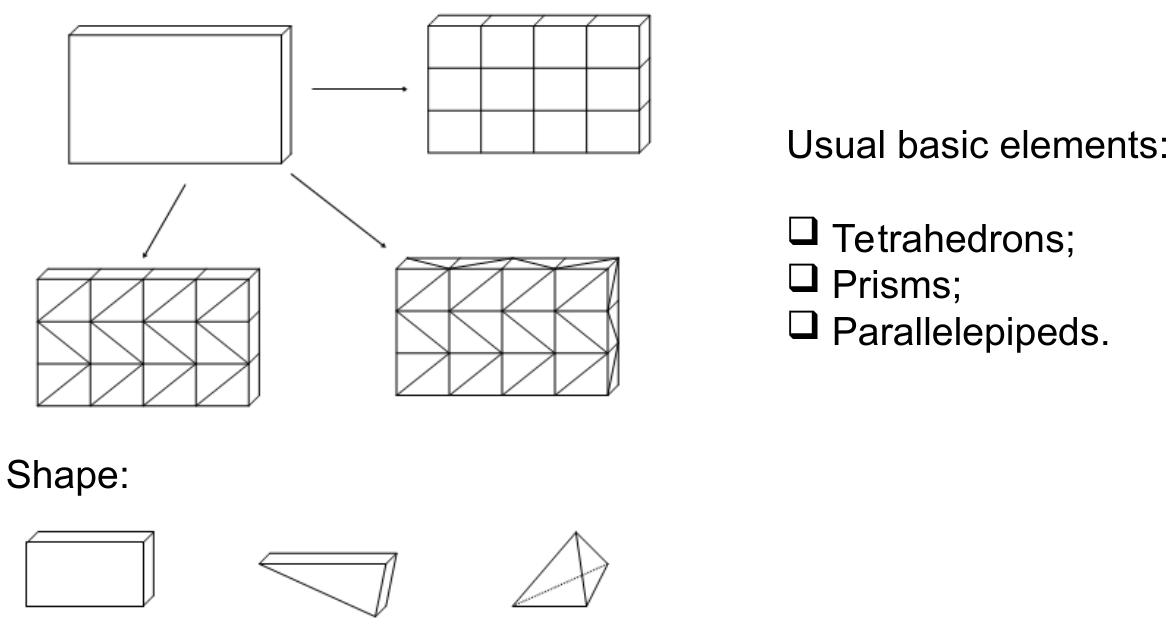
We should split the brick into basic elements (tetrahedrons, prisms or parallelepipeds)
Algebraic equation system (Алгебраическая система уравнений)
The magnetization of each element is considered constant (the simplest approach). More complex approximation schemes are not used.
To form a system of equations the method is collocations is used (we must choose some central point inside the element and the magnetic field which induced by all parts of the magnetic system is calculated just for this central point. And then, it’s assumed, that everywhere inside the element the magnetic field intensity has the same value)

Finite element method (Метод конечных элементов)
Main steps:
Problem formulation – problem domain, equation, boundary conditions, material properties.
Discretization of the problem domain.
Approximation of the unknown function.
Approximation of the solved equation and the boundary conditions.
Solution of the algebraic equation system (generally – nonlinear).
Post-processing.
Discretization (Дискретизация)
The element type choice
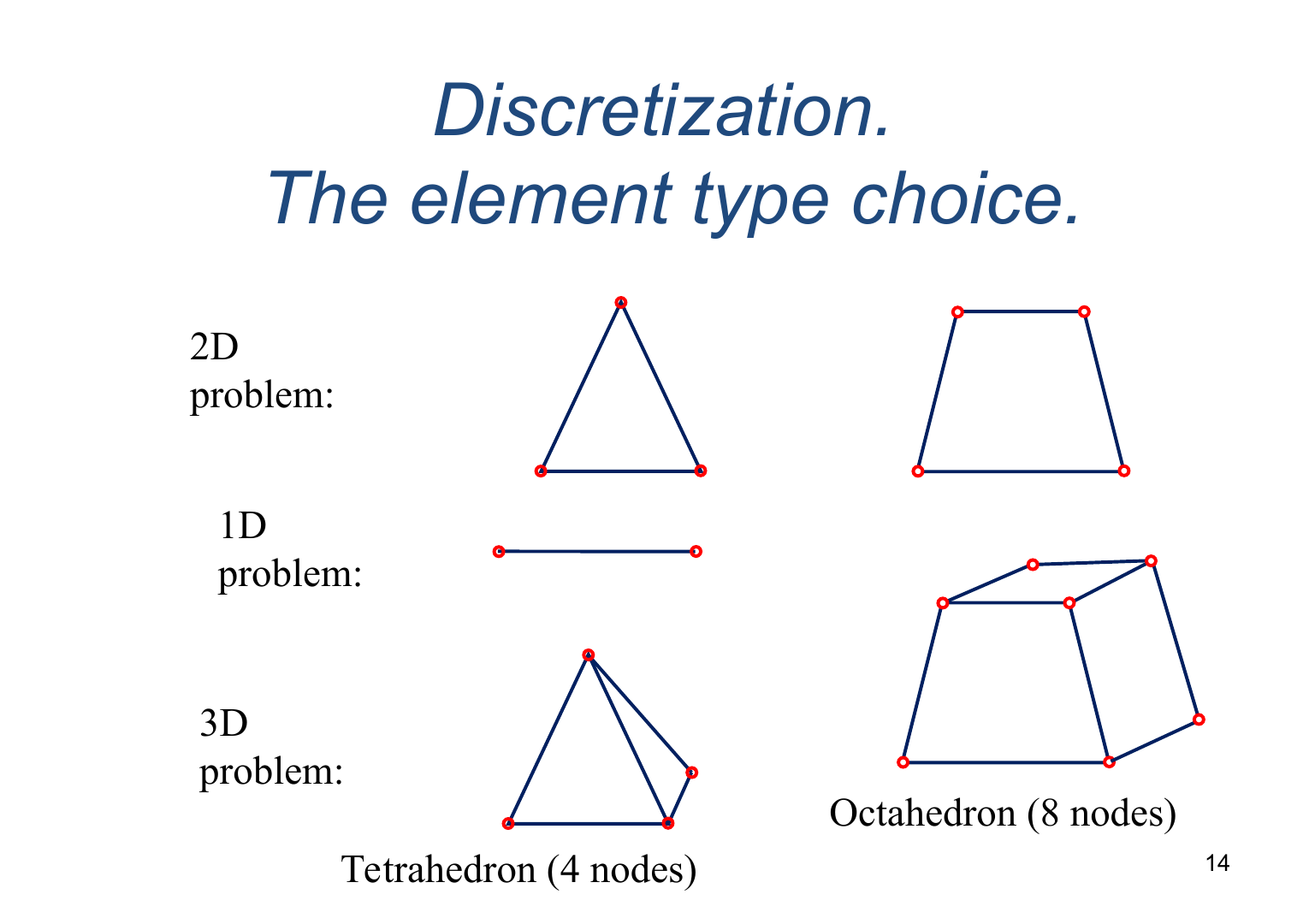
Examples of the mesh (triangles and quadrangles)
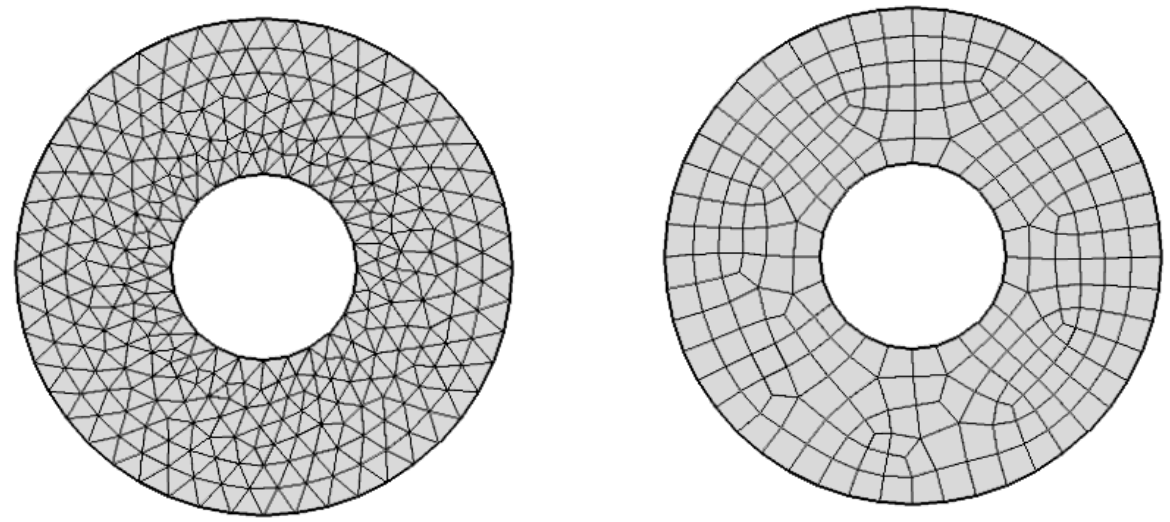
Linear approximation

The number of free parameters is the same!
In principle we can express coefficients a, b, c in terms of the nodal potentials U1, U2, U3
In linear approximation the vertices are the same with the nodal.
